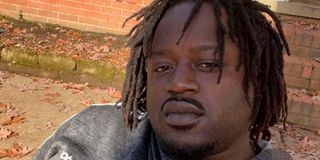Premium
‘They are animals’: Did police have to kill my bipolar son?

Ivor Otieno, who was killed by police in the United States.
By the time he died on March 6 at the hands of United States police, Kenyan-born Ivor Otieno, 28, was still handcuffed and in leg shackles. His death is the talk of all news channels in North America.
Otieno, who loved music and wanted to be a musician, had bipolar and anxiety disorders.
On the morning of March 3, Otieno’s mother, Caroline Ouko, noticed that her son was going through some distress.
During his teen years, he had been diagnosed with bipolar and anxiety disorders. She called her son’s psychiatrist’s office for help like she always did. She wanted them to take Otieno to the hospital.
“Irvo is going through mental distress, and if they can come out with someone who is specialised that can talk with him, and possibly help us get him to the hospital...” Ms Ouko recalled telling the person on the call at the psychiatrist’s office.
Meanwhile, Otieno had walked out and removed some light fixtures from a neighbour’s compound. Ms Ouko had offered to compensate the owner after explaining that her son had a mental illness.
Hours later, when she looked out the window and saw some police officers, she thought her son’s psychiatrist had contacted them to help take Otieno to the hospital. But they were not. Instead, they had been called by the neighbour, who reported that Otieno had stolen some lamps from his compound.
It was a scary moment for Ms Ouko, who relocated to the US in 1999 when Otieno was four years old.
“There were 10 to 12 police officers spread out in my front yard. I called for my son to come downstairs and held his hand. We walked out onto the front stoop. The officers had their tasers out ready to tase. I wrapped myself around my son; I was scared for his safety,” she told the press.
Ms Ouko asked the officers to put away the tasers because they were scaring her son. “I could see it in his eyes,” she told the press.
All through, Ms Ouko asked the police to call an ambulance because her son was unwell. When they handcuffed him, he refused to board the police vehicle. Luckily, an ambulance arrived shortly and Otieno freely boarded.
Denied access
He was taken to the nearby Henrico Doctors Hospital and Ms Ouko was assured that her son would receive the necessary treatment. But when she was denied permission to see her son that Friday, she suspected that things might go wrong – or had started to go wrong.
A statement released by police indicated that when Otieno was taken to the hospital for “further evaluation”, he “became physically assaultive towards officers”.
The officers then arrested him and transported him to the Warrant Services Unit at Henrico County Jail West where he was served with charges of “assault on a law enforcement officer, disorderly conduct in a hospital and vandalism”.
On learning that her son had been removed from the hospital, Ms Ouko visited Henrico jail and explained to officers there that Otieno was mentally ill and required medication.
“I said this is the wrong place for this young man; he’s in mental distress. Can you help me?”
It was a weekend. Ms Ouko gave the prison’s social worker her son’s medical history and a list of his medications. But she was told that the drugs would not be provided until Otieno was seen by a jail physician on Monday, March 6.
That Monday, Otieno appeared on a video monitor before Henrico General District Court. His mother noticed that he “raised his hands in a flailing motion ...almost lifeless”. She told the media that the expression on his face was “almost like a grimace like he’s gripping in pain”.
Ms Ouko tried to get her son out on bail and told the judge that he was ailing. According to local media, she overheard the judge say that Otieno would be taken to Central State Hospital. “And I said, ‘No, please, no. My son needs to be stabilised, he needs to be treated. Please get the medicine in him. We have a private doctor. If we can get him stable, he can come out.”
US lawyers are now asking why a mentally ill patient was removed from the hospital to jail and served with a charge sheet. Mark Bong, a lawyer who previously worked with police units in Henrico, told the press that he still wonders why the officers decided the best course of action was to take Otieno to jail.
“Somebody who is in a hospital setting and then is placed in a jail setting is probably getting insufficient treatment, especially on the weekend. The availability of medication and treatment is going to be greatly reduced in a jail environment than they would be in a hospital environment,” Bong said.
According to the family, Otieno had struggled with mental health issues since childhood.
“My son was the kind of man who had a big heart for others,” Ms Ouko said.
Otieno's last moments
After a national uproar, detectives agreed to show the family the footage from surveillance cameras that captured Otieno’s last moment. Family lawyer, Ben Crump said Otieno was never confrontational and did not pose a threat to the police.
“He was not violent nor aggressive,” Crump said. In one video footage, according to the lawyer, Otieno was in a “small cell, naked, with faeces all over the floor” in Henrico Jail.
“It is truly shocking that nearly three years after the brutal killing of George Floyd by police, another family is grieving a loved one who allegedly died in nearly the exact same manner—being pinned down by police for 12 agonising minutes,” said Crump who also represented the Floyd family.
Mark Krudys, another lawyer for the Otieno family, told the press that Otieno was brutalised. “He was carried about by his arms and legs into a vehicle like an animal.”
Similar sentiments were echoed by Otieno’s mother: “My son was treated like a dog, worse than a dog. I saw it with my own eyes… Now, I cannot be at his wedding. I’ll never see a grandchild … because someone refused to help him. No one stood up to stop what was going on.”
The New York Times has reported details of what happened to Otieno when he was taken to Central State Hospital. The video shows “at least seven deputies from the Henrico County Sheriff's office enter a room at Central State Hospital in Dinwiddie County dragging Mr Otieno, who is shirtless and in handcuffs and leg shackles. The deputies push him into a small couch and then force him to the floor, where they pinion him until his death while medical staff stand aside”.
“You see in the video, he is restrained with handcuffs. He has leg irons on, and you see in the majority of the video that he seems to be in between lifeless lives and unconsciousness,” said Crump.
Ann Cabell Baskervill, a state prosecutor under pressure from defence lawyers not to release the video, has told the court that this was a deliberate and cruel treatment and that Otieno was smothered to death by the weight of seven policemen on top of him. She has since charged the officers with murder while three medical officers were charged with manslaughter.
The prosecutor says the seven police officers removed Otieno’s restraints and waited for three hours before calling Virginia State Police to investigate the death.
When Ms Ouko was finally given a chance to watch the video, she was distraught. “What I saw was heartbreaking. It was disturbing. It was traumatic. My son was tortured.”
“They are animals. They are monsters,” Ms Ouko told NBC TV as she agreed to have the video on how her son was killed released to the public.
The family has been left asking how America looks at people with mental health conditions.
“At what point do we stop preserving life? At what point do we consider mental illness a crime?" asked his brother Leon Ochieng. “Can someone explain to me why my brother is not here right now? Can someone explain to me why my mother can’t sleep, can’t eat?"
The family believes that the system failed Otieno.
“There was a chance to rescue him. There was a chance to stop what was going on. I don’t understand how all systems failed him,” his mother said.





